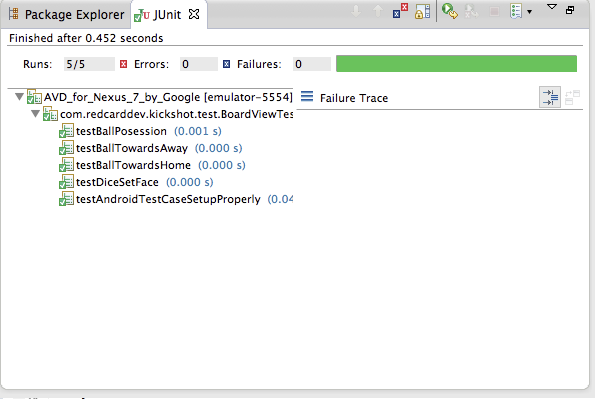Let the Testing Begin
In last weeks post I discussed the creation of the Board View, which is my first custom view. This week I want to talk about writing unit/integration tests for that view. I typically use a set of tools to perform unit tests as well as integration tests, and these tools seem to be a good place to start testing KickShot for Android.
- Android JUnit
- Robotium | Unit testing for Android functionality, allowing the tests of clicks
- Spoon | Multi-device test runner
Something I wanted to try this time around is have the testing code and the source code in the same repository. For previous projects the testing code was stored in it's own Eclipse project and its own separeate directory, resulting in its own git repo. This lead to checking multiple issue lists and confusion about where bugs should be logged.
Android documentation recommends using separate Eclipse projects for the Application and the Application's tests, but also shows how to store the Application Test project within the primary Applications file structure. Following their instructions, I created a tests folder in the KickShot Eclipse project and then created an Android Testing Project and set its path to /workspace/KickShot/tests now I have the best of Eclipse's multiple projects and a single git repository.
Now with the KickShot application and test projects created, I started writing tests.
Initially I thought I would be required to test it through an Android activity, but Android
provides a mock context in their AndroidTestCase class so I am able to run tests on the view without
initializing an activity. I started with tests that would force the changes requested in
Issue #7.
The execution can be seen below.

Those tests also make sure that the ball cannot
be moved past the goal line and that the ballTowardsX functions return the current line number; This allows the
game activity can handle shot logic. The Test Case ended up looking like:
class BoardViewTest extends AndroidTestCase
- private Board board;
- public BoardViewTest
- protected void setUp
- public void testBallTowardsAway
- public void testBallTowardsHome
- public void testBallPosession
- public void testDicePositionAway
- public void testDicePositionHome
- public void testDiceChangeFace
with the tests written I changed the Board API to the following:
class Board extends Android.View
- public Board(Context context, AttributeSet attrs)
- public boolean onTouchEvent(MotionEvent event)
- public Boolean ballPosession(int playerTurn)
- public Boolean diceChangeFace(int dice, int diceFace)
- public Boolean dicePositionHome(int dice)
- public Boolean dicePositionAway(int dice)
- public int ballTowardsAway(int steps)
- public int ballTowardsHome(int steps)
- private int ballMove()
- private void init()
- protected void onDraw(Canvas canvas)
Then I was able to change the internals of the Board class while not ruining its usage in the LevelOne Activity.
